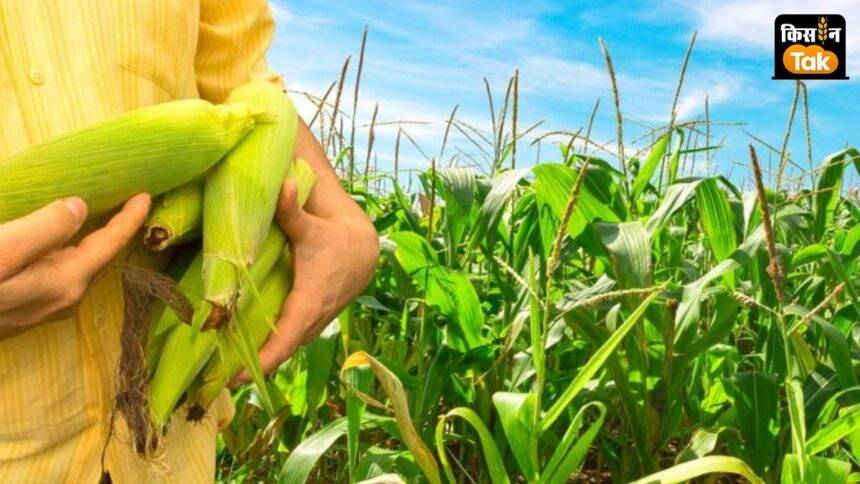Main Points In Hindi (मुख्य बातें – हिंदी में)
यहां पर किसानों के लिए सुझाव दिए गए हैं जो शीतकालीन मक्का बोने की तैयारी कर रहे हैं:
-
बुवाई का समय और तैयारी:
शीतकालीन मक्का की बुवाई अक्टूबर से नवंबर के बीच करनी चाहिए। मिट्टी की अच्छी तैयारी आवश्यक है, जिसमें 1-2 बार जुताई करना शामिल है। -
बीज चयन:
अच्छी उपज के लिए उच्च गुणवत्ता के बीजों का चुनाव करें। इसके लिए Hybrid Maize-HQPM-1, Seedtech-2324, और अन्य प्रकार के बीज उपयुक्त हैं। -
बीज की मात्रा और उपचार:
प्रति हेक्टेयर 20-22 किलोग्राम बीज की आवश्यक होती है और इसे बोने से पहले बीजों का उपचार करना चाहिए। -
खाद और पोषक तत्वों का उपयोग:
अगर मिट्टी की जांच नहीं की गई है, तो प्रति हेक्टेयर 150 किलोग्राम खाद का प्रयोग करना चाहिए, जिसमें नाइट्रोजन, फास्फोरस, पोटाश और सल्फर शामिल हैं। - वीडिंग और सिंचाई:
बुवाई के 20-25 दिन बाद पहले वीडिंग का सही समय है, और पहले सिंचाई 25-30 दिन बाद करनी चाहिए। इसके अलावा 3-4 बार वीडिंग की जरूरत होती है।
Main Points In English(मुख्य बातें – अंग्रेज़ी में)
Here are the main points from the provided text:


-
Sowing Period and Soil Preparation: Farmers should sow winter maize from October to November, with proper field preparation essential for higher yields. Loamy soil is ideal, requiring 1-2 plowings to ensure a crumbly texture.
-
Seed Selection and Quantity: Recommended improved maize varieties include Hybrid Maize-HQPM-1, Seedtech-2324, and others, depending on the purpose (human consumption, fodder, etc.). Approximately 20-22 kg of seed is needed per hectare for sowing.
-
Fertilizer Application: If soil testing is not conducted, a general guideline is to apply 150 kg of hybrid maize fertilizer, which includes specific quantities of nitrogen, phosphorus, potash, and sulfur. Zinc sulphate should be added if zinc deficiency is present.
-
Weeding and Irrigation Schedule: The first weeding should be done 20-25 days after sowing, followed by irrigation 25-30 days post-sowing. A total of 3-4 weedings may be necessary, utilizing manual removal or herbicides to manage weeds effectively.
- Pest Management: To control seed-borne diseases, seeds should be treated with fungicides like Carvendazim or Thiram before sowing, ensuring the health of the plants from the start.
Complete News In Hindi(पूरी खबर – हिंदी में)
जो किसान सर्दियों में मक्का बोने की तैयारी कर रहे हैं, उन्हें भारतीय कृषि अनुसंधान परिषद, पूसा के कृषि वैज्ञानिकों ने बढ़िया उपज हासिल करने के लिए कुछ सुझाव दिए हैं। कृषि वैज्ञानिकों के अनुसार, सर्दियों में मक्का की बोआई अक्टूबर से नवंबर के बीच करनी चाहिए। इसलिए, किसानों के पास अभी लगभग 10 दिन हैं। वैज्ञानिकों ने किसानों को मक्का की बोआई, कटाई और कीट प्रबंधन के संबंध में भी सलाह दी है।
भारतीय कृषि अनुसंधान परिषद, पूसा के वैज्ञानिकों के अनुसार, मक्का भारत की एक प्रमुख फसल है। इसका उपयोग मानव आहार के रूप में, अनाज और पशुओं के लिए चारे के रूप में किया जाता है। आमतौर पर, रबी मौसम में मक्का की फसल से अधिक उपज प्राप्त होती है। इस मौसम में मक्का की बोआई के लिए खेत की मिट्टी का सही ढंग से तैयार होना बहुत महत्वपूर्ण है।
खेत की तैयारी और बीज चयन
रबी मक्का के लिए दोमट मिट्टी सबसे उपयुक्त होती है। सामान्यत: मिट्टी को 1-2 बार जुताई करके भुरभुरी बनाएं। यदि मिट्टी में नमी की कमी है, तो खेत को जुताई करके तैयार करें। रबी मक्का के लिए बेहतर किस्में जैसे हाइब्रिड मक्का-HQPM-1, Seedtech-2324, KH-5991, Amber-Popcorn, VL Amber Popcorn, और हरी मक्का के लिए Priya Sweetcorn, Madhuri Sweetcorn बोई जा सकती हैं। चारे के लिए किसान अफ़्रीकी टॉल, J-1006 किस्में भी बो सकते हैं। ठंडी जगहों पर बोने के लिए GK 3150 हाइब्रिड और शालीमार मक्का हाइब्रिड 4 का उपयोग भी किया जा सकता है।
एक हेक्टेयर में मक्का बीज की मात्रा
रबी मौसम में मक्का की बोआई के लिए 20-22 किलोग्राम बीज की आवश्यकता होती है। इससे लगभग 85-90 हजार पौधे प्रति हेक्टेयर प्राप्त हो सकते हैं। बोआई से पहले बीजों की सफाई करना आवश्यक है। पौधे से पौधे की दूरी 20-25 सेमी और पंक्ति से पंक्ति की दूरी 60 सेमी होनी चाहिए। बीजों को बीमारियों से बचाने के लिए उन्हें Carvendazim 50% के 2 ग्राम या Thiram के 2.5 ग्राम प्रति किलोग्राम के हिसाब से उपचारित किया जाना चाहिए।
यदि मिट्टी का परीक्षण नहीं किया गया है, तो खाद की मात्रा
यदि खेत की मिट्टी का परीक्षण नहीं किया गया है, तो सामान्यत: 150 किलोग्राम हाइब्रिड मक्का का उपयोग बोआई के समय किया जाता है। इसमें 75 किलोग्राम नाइट्रोजन, 60 किलोग्राम फास्फोरस, 40 किलोग्राम पोटाश और 40 किलोग्राम सल्फर का इस्तेमाल करें। यदि पैकaged मक्का बो रहे हैं, तो 120 किलोग्राम नाइट्रोजन, 60 किलोग्राम फास्फोरस, 40 किलोग्राम पोटाश और 30 किलोग्राम सल्फर प्रति हेक्टेयर की दर से डालें। यदि मिट्टी में जिंक की कमी है, तो बोआई से पहले 25 किलोग्राम जिंक सल्फेट डालें।
बोआई के बाद पहले निराई का सही समय
मक्का की बोआई के बाद पहले निराई का सही समय 20-25 दिन होता है। इससे खेत में कोई杂草 नहीं रहेगी। यदि बहुत देर हो जाती है, तो杂草 नाइट्रोजन खा लेगी और पौधों को विकसित नहीं होने देगी। इसी प्रकार, बोई के 25-30 दिन बाद पहला सिंचाई करें। जब पौधे घुटने की ऊंचाई के लगभग हों या करीब 30-35 दिन बाद, 87 किलो यूरेa डालें।
कृषि वैज्ञानिकों ने कहा कि मक्का फसल में杂草 नियंत्रण के लिए 3-4 निराई की आवश्यकता होती है। खड़ी फसलों में अधिक नमी के कारण杂草 का प्रकोप बढ़ जाता है। निराई की गहराई 4-5 सेमी होनी चाहिए और मात्रा 500 ग्राम से ज्यादा नहीं होनी चाहिए, अन्यथा पौधों की जड़ों को नुकसान होने की संभावना होती है।杂草 को उनकी वृद्धि के समय उखाड़ना सबसे अच्छा उपचार है। मक्का फसल के लिए हर्बिसाइड का भी उपयोग किया जा सकता है।
यही भी पढ़ें –
Complete News In English(पूरी खबर – अंग्रेज़ी में)
For the farmers who are preparing to sow maize in winter, the agricultural scientists of Indian Council of Agricultural Research, Pusa have given tips to achieve bumper yield. According to agricultural scientists, sowing of winter maize should be done from October to November. Therefore, farmers still have about 10 days time. Experts have also given advice to farmers regarding maize sowing, harvesting and pest management.
According to agricultural scientists of Indian Council of Agricultural Research, Pusa, maize is one of the main crops of India. It is used in the form of human food, grain and straw for feeding animals. Generally, higher yield can be obtained from maize crop in Rabi season in the country. For sowing of maize in this season, it is important for the soil of the field to be well prepared.
Field preparation and seed selection
Loamy soil is suitable for Rabi maize. Generally, make the soil crumbly by doing 1-2 plowing with soil turning plow or disc harrow. If there is lack of moisture, prepare the field by plowing. For sowing of Rabi maize, improved varieties like Hybrid Maize-HQPM-1, Seedtech-2324, KH-5991, Amber-Popcorn, VL Amber Popcorn, Sweet Maize (Sweetcorn) for green corn, Priya Sweetcorn, Madhuri Sweetcorn and for fodder. Farmers can sow maize African Tall, J-1006 varieties. At the same time, seeds of GK 3150 Hybrid and Shalimar Maize Hybrid 4 can also be used for sowing maize in colder areas.
How much maize seed will be required in one hectare
20-22 kg for sowing of maize in Rabi season. Use seeds per hectare. With this, about 85-90 thousand plants can be obtained per hectare. Seed purification is necessary before sowing. Row to row distance 60 cm. And the distance from plant to plant is 20-25 cm. Keep it same. To protect against seed borne diseases, the seeds should be treated with Carvendazim 50% at 2 grams or Thiram at 2.5 grams per kg. The seeds should be treated and sown accordingly.
How much fertilizer to apply if soil is not tested
If the soil of the field is not tested, generally 150 kg of hybrid maize is used at the time of sowing. Nitrogen, 75 kg. Phosphorus, 60 kg. Potash and 40 kg. Use sulphur. Whereas, for packaged maize 120 kg. Nitrogen, 60 kg. Phosphorus, 40 kg. Potash and sulfur 30 kg. Use at the rate of per hectare. If there is zinc deficiency in the soil then apply 25 kg before sowing. Zinc sulphate must be added.
Right time for first weeding after sowing
The right time for first weeding after sowing of maize is 20-25 days. Due to this there will be no weeds in the field. In case of too much delay, weeds will eat up the nutrients and will not allow the plant to flourish. Similarly, do the first irrigation 25-30 days after sowing. 87 kg per hectare when the plant is about knee height or about 30-35 days after sowing. Do top dressing of urea.
Agricultural scientists said that maize crop requires 3-4 weeding to control weeds. Due to excess moisture in standing crops, weed infestation is more. The depth of weeding is 4-5 cm. It should not exceed 500 g, otherwise there is a possibility of damage to the roots of the plants. The best treatment is to uproot the weeds at the time of their growth. Herbicide can also be used for maize crop.
Read this also –










